Think you can’t bake artisan sourdough bread at home? Think again! Sourdough Bread: a Beginner’s guide is your go-to recipe resource for simple, easy sourdough bread without kneading. Make the dough in the morning or at night- it will come together in under 10 minutes.
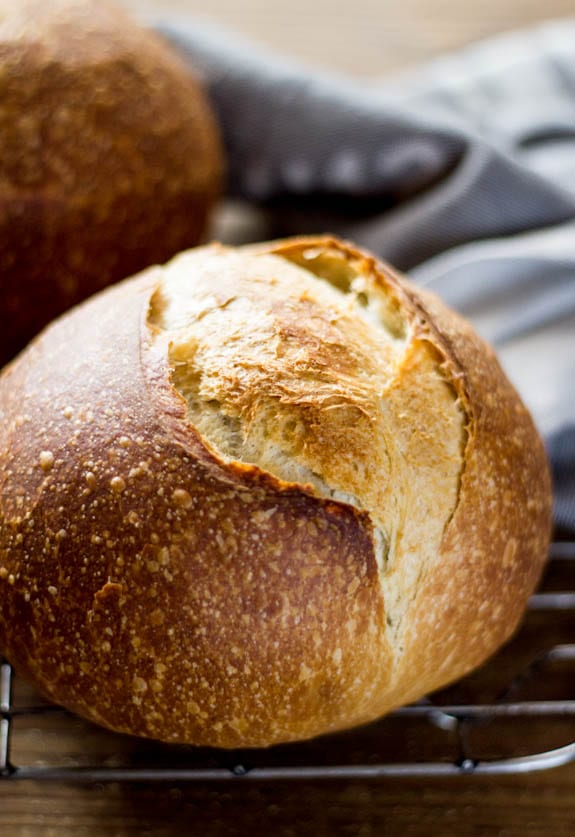
In 2013, my resolution was to bake more bread.
I researched, tested and baked countless loaves with both good and mixed results. My journey began with this no-knead artisan bread recipe and eventually, I worked my way up to the holy grail: Sourdough. My passion for creating easy sourdough bread recipes and preserving traditional culinary arts inspired my bestselling book Artisan Sourdough Made Simple which has connected me to like-minded bakers all over the world! Lucky me 😉
If you’re curious about sourdough bread (and don’t know where to begin), trust me, you’re in the right spot. My beginner sourdough bread recipe has been THE MOST popular recipe on my blog for over a decade and continues to earn millions of page views a month. Welcome to the journey!
What You’ll Learn
In this tutorial, you’ll learn how to make simple sourdough bread with step-by-step instructions and videos for guidance. There’s no kneading involved, and a bread machine or a stand mixer is not required. My sourdough bread recipe is perfect for beginners. I’ll explain a complex topic in simple terms without the stress! But before you dive in, here’s a secret: sourdough bread is more than just a recipe… it’s an understanding.
There are similar sourdough bread recipes out there and yet no two loaves look alike. The process is all about method, timing and personal touch. Use this tutorial as a guide and make your own adjustments as you go. Once you have a few loaves under your belt, the process will become an imminent rhythm, and in the end, you will have created your very own masterpiece that is the ultimate reward. Just don’t forget to eat your mistakes (might I suggest homemade sourdough breadcrumbs)?
Jump To
- Sourdough Bread Recipe
- Step by Step Instructions
- Sourdough Starter 101
- Sample Baking Schedule
- Sourdough FAQ
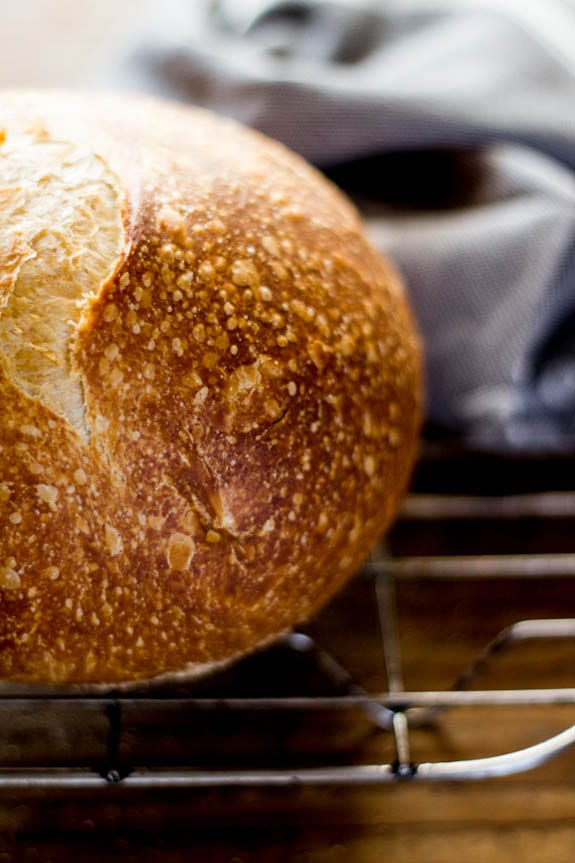
So, What is Sourdough?
In a nutshell, sourdough is slow-fermented bread.
It’s unique because it does not require commercial yeast in order to rise. Instead, sourdough bread is made with a live fermented culture a sourdough starter, which acts as a natural leavening agent.
Sourdough is known for its characteristic tangy flavor, chewy texture and crisp, crackly crust. From a health standpoint, it dominates when compared to supermarket loaves. The naturally occurring acids and long fermentation help to break down the gluten, making it more digestible and easy for the body to absorb. And it tastes darn good!
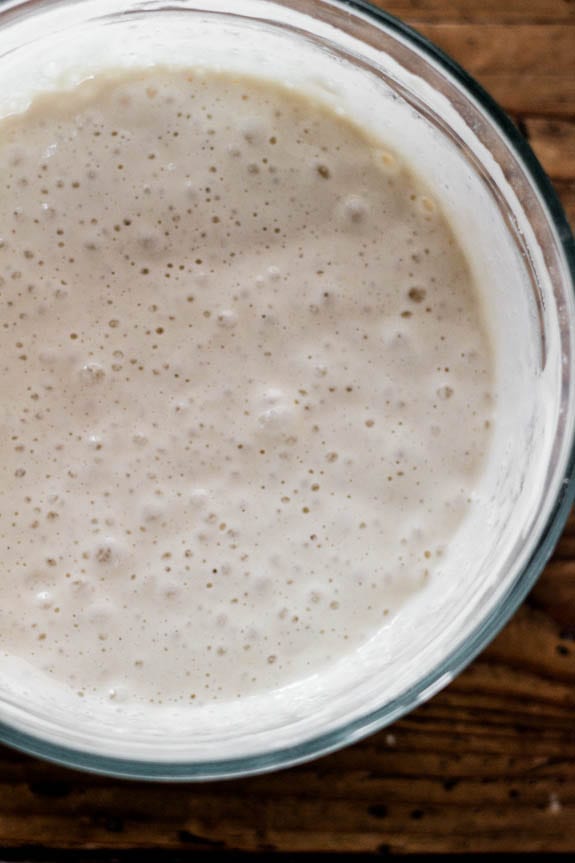
Sourdough Starter 101
Before you begin, you’ll need a sourdough starter.
Simply put: a sourdough starter is a live culture made from flour and water.
Once combined the mixture will begin to ferment, cultivating the naturally occurring wild yeasts and bacteria present within the mixture. A small portion of this culture is used make your bread dough rise.
But it doesn’t stop there.
Your starter must be kept alive with regular feedings of flour and water to maintain its strength for maximum rising power.
How to Feed your Sourdough Starter
Every baker has their own method, and with practice you’ll eventually develop your own routine.
Here’s my method: I pour off some of the culture (about half) and then feed what’s left in the jar with equal weights of flour and water. I whisk well with a fork until it’s lump-free. Then, I let it rest at room temperature or in a warm spot (75-80º F/ 24-26º C is ideal) until it becomes bubbly and active.
PS: I use this the jar for my sourdough starter and I LOVE it.
When is my Starter Ready To use?
Your stater is ready to use when it becomes bubbly and doubles in size.
This can take anywhere from 2-12 hours or more depending on temperature (the warmer the better) and the condition of your starter. Be patient!
Float Test: If you’re still unsure whether it’s ready to use drop a small amount, about 1 tsp, into a glass of water. Do this when the starter is a peak height before it collapses. If it floats to the top it’s ready to use. If it sinks, your starter should be fed again.
Where to Obtain a Sourdough Starter
All sourdough starters are different.
They can be made from scratch, purchased online, or if you’re lucky, someone will share a portion of their starter with you.
Starters range from thick to thin in texture and can be made with a variety of flours. I use two different starters; one is homemade and the other was a gift from my friend Celia. She dried a portion of her starter and mailed it all the way from Sydney, Australia.
How To Use A Starter
After you’ve fed your starter and it’s bubbly and active, pour the amount you need out of the jar to weigh or measure for your recipe. That’s it.
Then, don’t forget to feed what’s left in the jar with more flour and water to keep the process going.
Any leftover sourdough starter can be used to make sourdough discard recipes, even my homemade sourdough pasta.
Storage Options
If you only bake a few times a month, keep your starter in the fridge and feed it once a week. If you’re an avid baker, store your starter at room temperature and feed it at least once a day.
Looking for more info on sourdough starters? Check out Feeding Sourdough Starter: My Best Tips & Tricks & Sourdough Discard 101: Recipes & Faqs Answered.
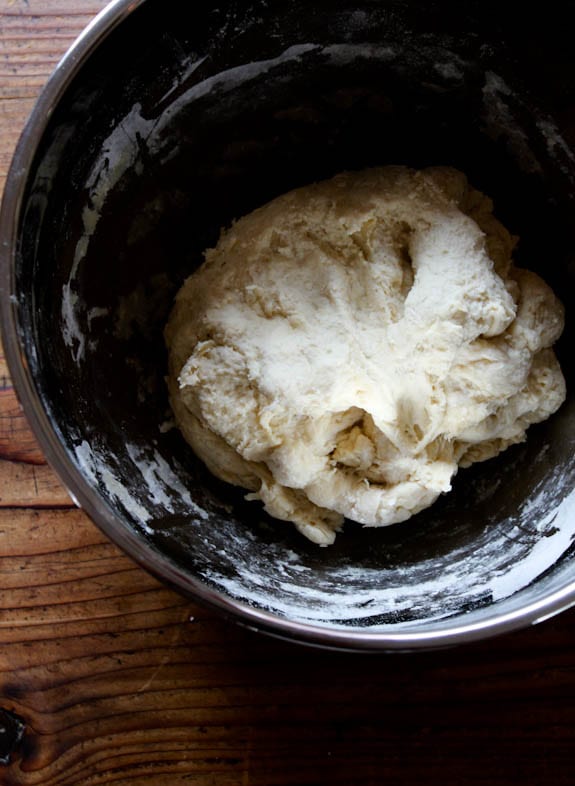
How to Make Sourdough Bread: Step-By-Step Guide
Step #1: Mix The Dough
Combine the following ingredients in a large bowl (I use a fork):
- 250 g water
- 150 g bubbly, active sourdough starter
- 25 g olive oil
Add:
- 500 g bread flour (such as King Arthur)
- 10 g fine sea salt
Squish the mixture together with your hands until the flour is fully absorbed. The dough will feel dry, rough and shaggy.
Cover the bowl with plastic wrap, reusable wax wrap, or a very damp kitchen towel and let rest or ‘autolyse’ for about 30 minutes. After the dough has rested, work it into a ball directly in the bowl (it doesn’t have look perfect).
TIP: For best results, weigh all of your ingredients with a digital kitchen scale. Measuring cups are not as accurate. Please visit Sourdough FAQ for more details.
What is Autolyse?
This is the first resting period right after you mix the dough.
It jumpstarts gluten development without kneading. Strong gluten = good bread.
For timing, autolyse can range anywhere from 15 minutes to 1 hour or more depending on the type of bread you’re making and your own personal baking schedule. A minimum of 30 minutes works best for this recipe. However, when time permits, I’ll let it go for an hour. The dough will become more soft and manageable to work with afterwards.
A Note on Salt: some bakers prefer to add salt only after autolyse because it might slow down the gluten development. I’ve followed this technique for years, but no longer do so. I prefer to mix everything all at once. It’s practical, effective and produces excellent loaves (plus, you won’t forget to add the salt later on!). I’ll leave the choice up to you.

Step #2: Bulk Rise
Now the dough is ready to rise.
Cover the bowl and let rise at room temperature, about 68-70 F.
How Long will it take?
The dough is ready when it has doubled in size and no longer looks dense.
This can take anywhere from 3-12 hours depending on your current room temperature, the potency of your sourdough starter and the specifics of your surrounding environment.
For example, in the summer the dough can take anywhere between 2-4 hours @ 85º F/ 29º C. In the winter, it will take longer about 10-12 hours @ 68º F/ 20º C. Temperature controls time.
And remember: because sourdough bread does not contain instant yeast it will take longer to rise. Watch the dough and not the clock. Be flexible.
Optional Step: Stretch and Fold the Dough
About 30 minutes into the bulk rise, you have the option to perform a series of ‘stretch & folds’ to strengthen the bread dough {click here for a step-by-step tutorial}. Although it’s not mandatory, this technique will add height and structure to the finished loaf and it’s fun to do.
Watch the video below!
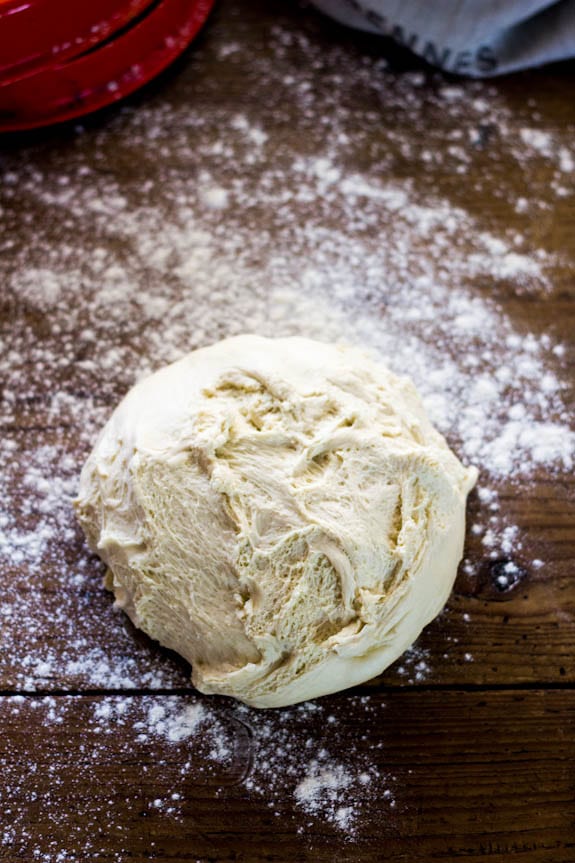
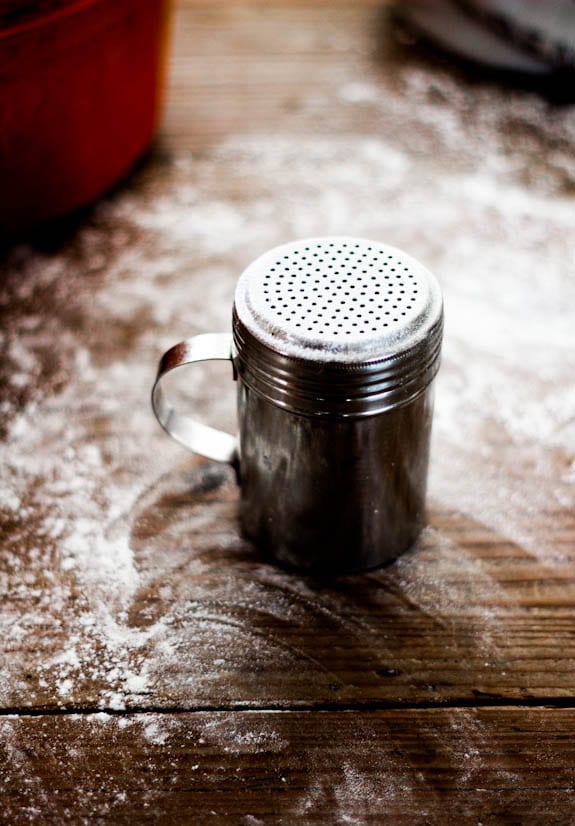
Step #3: Divide & Shape The Dough
Remove the dough onto a lightly floured surface.
Cut the dough in half to make 2 loaves, or leave it whole for a single loaf.
How to Shape a Round Sourdough Boule (Loaf)
Starting at the top, fold the dough over toward the center. Give it a slight turn, and then fold over the next section of dough. Repeat until you have come full circle. Or, use the envelope shaping technique outlined below.
Watch the video!
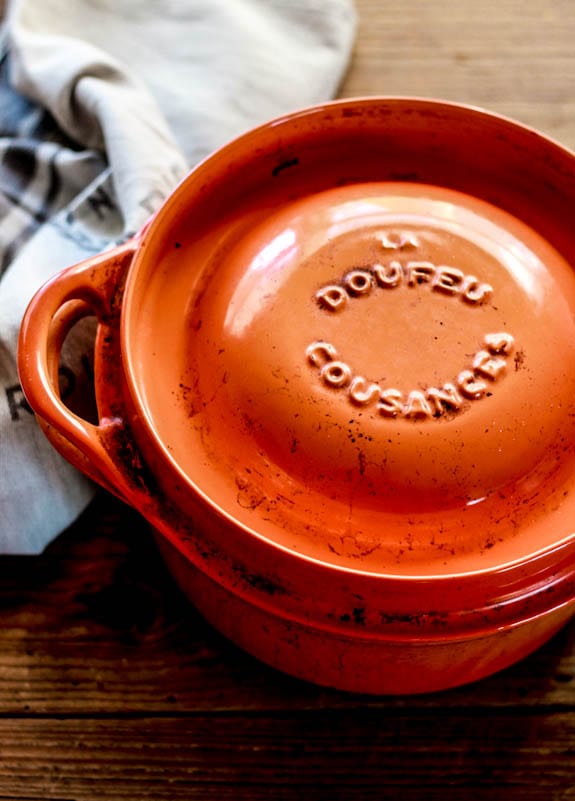
Step #4: Choose a Baking Pot
I bake my sourdough bread in a Dutch oven.
You can also try the Challenger Bread Pan, another vessel I use for baking, that can accommodate both round and oval shaped loaves.
The pot traps in heat and moisture which is essential to achieving artisan style bread at home.
Steam plays a key role in how the bread will open up or ‘bloom’ while baking and the Dutch oven helps to control this process.
You can use any oven safe pot that can heat up to 450º F/ 232º C (including the lid and handles).
TIP: In the past, I’ve tried baking on pizza stones and cookie trays with no luck. The crust would harden too quickly, forcing the bread to tear on the bottom and sides. I used various steaming methods to remedy this, however I found them to be extremely cumbersome and not realistic for everyday use. Nothing worked. The lack of moisture in my home oven was evident and using a pot for baking was the only practical solution.
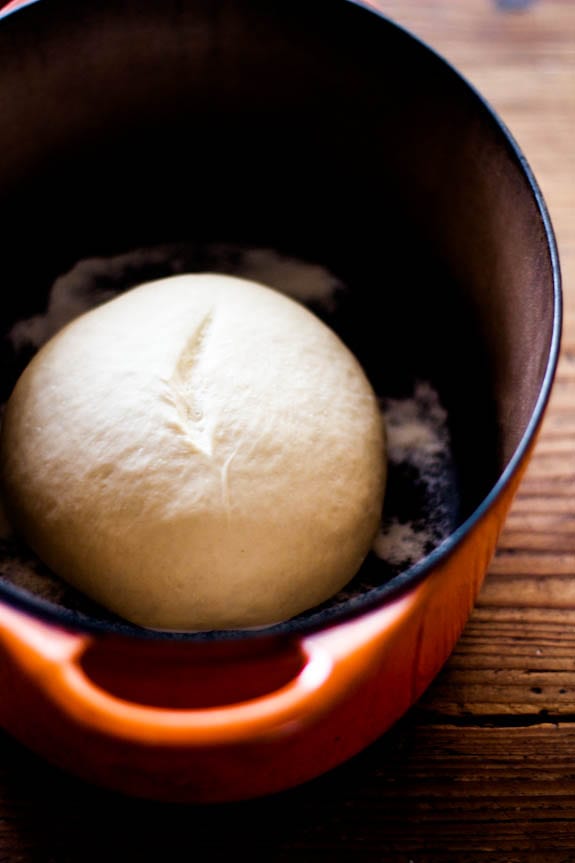
Step #5: Second Rise
After shaping the dough, it needs to rise again.
Generously coat the bottom of your Dutch oven with cornmeal (or line the bottom with non-stick parchment paper instead) and place the dough inside.
This time, the dough will rise for a shorter period about 30 minutes- 1 hour.
The dough is ready when it’s puffy and no longer dense. It does not need to double in size.
Preheat your oven to 450º F/ 232º C during the tail end of the second rise.
TIP: Instead of doing a free form second rise in the Dutch oven, use a cloth lined proofing basket or 8-inch bowl instead. Either option will contain the dough and hold its shape properly during the second rise.
Step #6: Score The Dough
After the second rise, and right before the dough goes into the oven, make a slash about 2-3 inches long down the center of the dough.
This allows the steam to escape and for the dough to expand during baking.
You can use a small serrated knife, paring knife or bread lame.
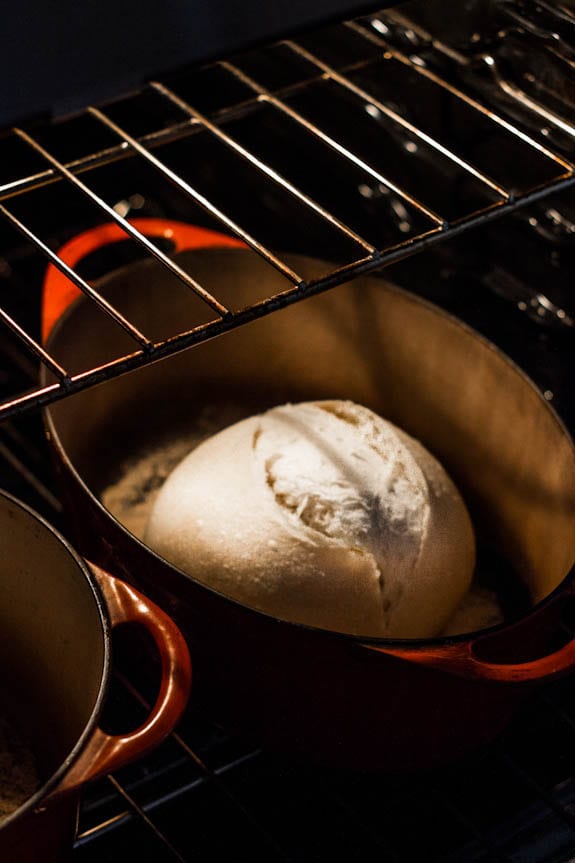
Step #7: Bake The Sourdough Bread
Place the lid on top of the pot and reduce the oven temperature to 400º F/ 204º C.
Bake on the center rack for 20 minutes.
When 20 minutes is up, remove the lid. Your bread will be pale and shiny like the picture above.
Continue to bake (uncovered) for an additional 40 minutes or until deep, golden brown. The internal temperature should read 205-210º F/ 96-98º C.
Cool on a wire rack for at least a 1 hour before slicing. Be patient!
If you cut into it too soon, the texture will be gummy…
TIP: During the last 10 minutes of baking, crack open the oven door (optional). This allows the moisture to escape, leaving your sourdough bread with a crisp crust. Alternatively, remove the bread from the pot and let it bake directly on the rack. The latter produces a more crisp crust.
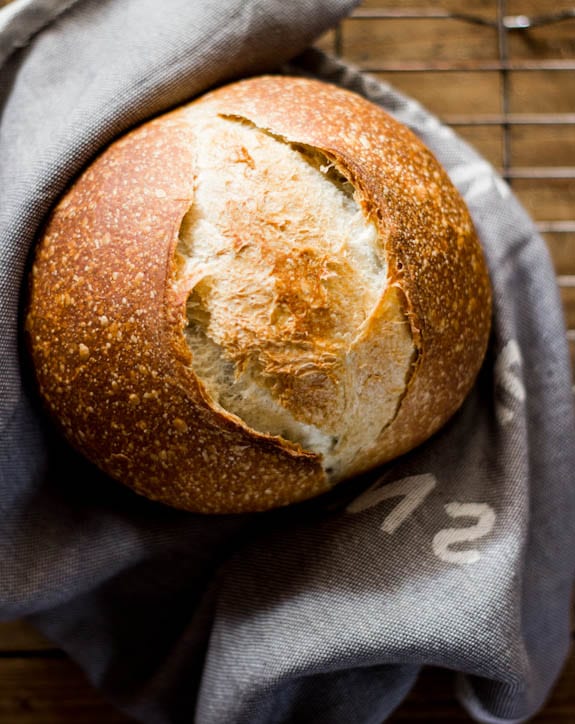
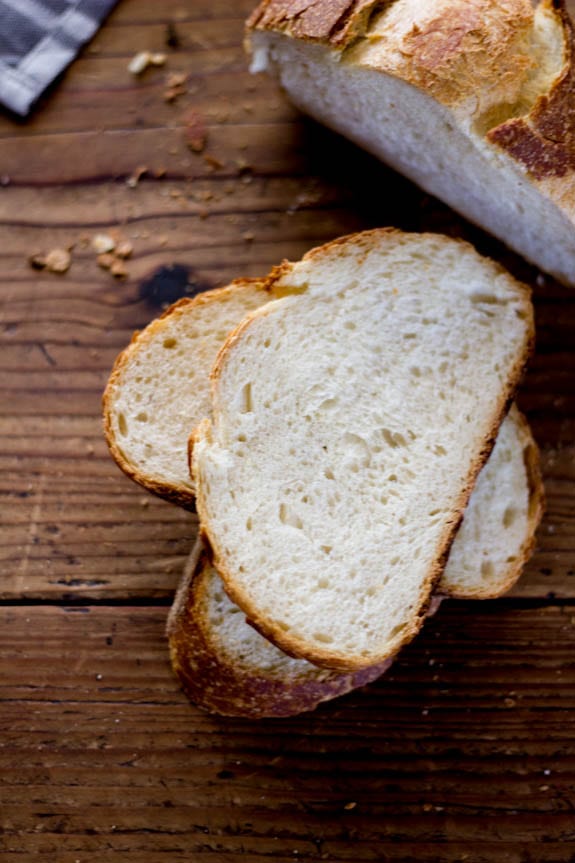
Additional Sourdough Recipes & Resources
Sourdough Starter:
- Beginner Sourdough Starter {Recipe}
- Feeding Sourdough Starter: My Best Tips & Tricks
- Sourdough Discard 101: Recipes & Faqs Answered
Sourdough Bread Recipes:
- Beginner’s Guide to Sourdough Focaccia Bread
- Best Sourdough Pizza Crust (No steel or stone!)
- Best Sourdough Pasta (1 hour or Overnight)
- Light Whole Wheat Sourdough
- Easy Sourdough Sandwich Bread
- Soft Sourdough Cinnamon Rolls
- Best Sourdough Pancakes
Sourdough Bread Tips & Techniques:
- How to Stretch and Fold Sourdough {Video}
- How to Shape a Round Sourdough Boule {Video}
- Why Won’t My Sourdough Bread Rise?
- Bread Flour vs. All Purpose Flour: What’s the Difference?
Sourdough Tools & Supplies:
Baking Schedule
- Friday Evening: Feed your starter, cover the jar, and leave it on the counter overnight. If you keep your starter in the fridge, it might need two feedings to perk back up (feed it in the morning & in the evening).
- Saturday Morning: Check your starter: if it’s alive and bubbling, you can make the dough to rise during the day. Or, feed it again in the afternoon to make the dough in the evening for an overnight rise. Remember to use the float test mentioned above to make sure your starter is ready to use.
- Saturday Morning/Evening (or whenever your starter is ready): Make the dough. Leave on the counter to bulk rise at room temperature. In the summer, if your dough rises quickly and you’re not ready to bake, cover the whole bowl with lightly oiled wrap and chill until ready to use.
- Sunday Morning: cut and shape the dough. Place in Dutch oven for second rise. Slash. Bake. Cool. Eat.
Sourdough Bread Recipe
Print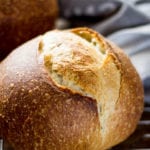
Sourdough Bread: A Beginner’s Guide
- Prep Time: 13 hours
- Cook Time: 1 hour
- Total Time: 14 hours
- Yield: 1 loaf
- Category: Sourdough Bread Recipes
- Method: Oven-Baked
- Cuisine: American
- Diet: Vegan
Description
This beginner sourdough recipe is perfect for bakers looking to jump right in! It’s is a low-hydration dough, meaning it will yield a ‘tight’ crumb (small holes). It is great for sandwiches and toast.
Ingredients
- 150g/ 5.35 oz bubbly, active sourdough starter
- 250g/ 8.80 oz warm water, preferably filtered*
- 25g/ .90 oz olive oil
- 500g/ 17.65 oz bread flour (not all purpose flour)
- 10g/ .4 oz fine sea salt
- fine ground cornmeal, for dusting
*For a more soft and pliable dough, you can increase the water up to 300 g- 325 g total. Please use a cloth lined bowl (instead of the Dutch oven for the second rise).
**You will need a 5 1/2 or 6 quart Dutch oven for baking
***This recipe was tested with King Arthur Bread Flour, Gold Medal Bread Flour, Pillsbury Bread Flour
Instructions
Make the Dough
Whisk the starter, water, and olive oil in a large bowl. Add the flour and salt. Squish everything together with your hands until all of the flour is absorbed. The dough will be dry and shaggy. Cover the bowl with plastic wrap, reusable wrap or a clean, very damp kitchen towel. Let rest (autolyse) for 30 minutes or up to 1 hour, if preferred.
After the dough has rested, work the dough in the bowl into a rough ball, about 15 seconds.
Bulk Rise
Now the dough needs to rise.
Cover the bowl with wrap or a very damp kitchen cloth. Let rest in a warm spot to rise. The dough is ready when it no longer looks dense and has doubled in size. This can take anywhere from 3-12 hours depending on the temperature of your ingredients, the potency of your starter and surrounding environment. For example, in the summer rise times can take anywhere between 2-4 hours @ 85º F/ 29º C whereas in the winter, the dough will take about 10-12 hours @ 68º F/ 20º C.
Optional Step: Stretch & Fold the Dough
During bulk rise, you have the option to perform a series of ‘stretch & folds’ to strengthen the dough. Start 30 minutes into the bulk rise. Gather a portion of the dough, stretch it upwards and then fold it over itself. Rotate the bowl ¼ turn and repeat this process until you have come full circle to complete 1 set. Do this once or twice spaced about an hour apart. Although this step is not mandatory, it will increase the total volume and height of your bread. Click here for a step-by-step video tutorial.
Cut & Shape the Dough
Divide your work surface in half; lightly flour one side (for cutting) and leave the other half clean (for shaping).
Remove the dough from the bowl, and place onto the floured section so that it does not stick. You do not need to ‘punch down’ the dough; it will gently deflate as you fold and shape it.
Cut the dough in half to make 2 loaves, or leave it whole for a single loaf.
To shape, use a bench scraper to move your dough to the non-floured section (if there is any flour present, it will be difficult to shape- brush away any excess). Starting at the top, fold the dough over toward the center. Give it a slight turn, and then fold over the next section of dough. Repeat until you have come full circle.
Then flip the dough over and place it seam side down. Using your hands, gently cup the sides of the dough and rotate it, using quarter turns in a circular motion. You can also pull it towards you to even out the shape. Repeat this process until you are happy with its appearance. *See note below.
Second Rise
Now the dough needs to rise again, but for a shorter period of time.
Coat the bottom of your Dutch oven with cornmeal. Alternatively, use parchment paper to prevent sticking (this is what I do, now). Place the dough inside for a second shorter rise, about 30 minutes to 1 hour and cover with the lid of the pot or a very damp cloth. The dough ready when it is slightly puffy but not double in size.
Preheat your oven to 450º F/ 232º C towards the tail end of the second rise.
Score the Dough
Right before your bread goes into the oven, make a shallow slash about 2-3 inches long (or more) in the center of the dough. Use a bread lame, sharp pairing or a small serrated steak knife. The cut should be about 1/4-inch deep.
Bake the Dough
Place the bread into the oven on the center rack (lid on) and reduce the temperature to 400° F/ 204° C. Bake for 20 minutes. Remove the lid, and continue to bake (uncovered) for an additional 40 minutes or until deep, golden brown. Keep in mind that all ovens are different; you might have to make minimal adjustments to these temperatures.
You can also take the internal temperature of your bread to double check that it is done. For sourdough, it should read about 205-210º F/ 96-98º C.
Remove the bread from the oven, and cool on a wire rack for at least an hour before slicing. Don’t cut too soon or else the inside will have a gummy texture!
Notes
When shaping, the idea is for the dough to catch enough surface tension on a non-floured area in order to create a tight ball. If there is flour present, it will slide around… and drive you nuts.
Sourdough FAQ
1.) I only have all purpose flour. Can I still make this recipe?
For best results, use bread flour for this dough. If you only have all purpose try my Artisan Sourdough with All Purpose Flour instead.
2.) Can I add whole wheat flour to this recipe?
You can, but I wouldn’t. The dough will be too dry and dense without adjusting the water quantity. Try my Light Whole Wheat Sourdough for more whole grain goodness.
3.) Your beginner recipe here uses 150g of sourdough starter. The Everyday Sourdough in your book uses only 50g. What’s the difference? And why?
- When I first learned how to bake sourdough bread, I used 150g of starter. Overtime, it was too much to maintain (especially when doubling and tripling recipes). So, I scaled down. That’s why most recipes in my book Artisan Sourdough Made Simple include 50 g of starter instead. One amount is neither right or wrong; it’s just a matter of preference.
4.) What’s the purpose of olive oil in this recipe?
Adding olive oil to sourdough was the method I followed when I first learned how to bake. The natural fat emulsifies the dough and makes a plush crumb.
5.) Why do some of your recipes call for the second rise in a Dutch Oven? And others in a cloth- lined bowl?
The freeform Dutch oven second rise will only work with dry, low hydration doughs (like this one) because it will not spread out too much. On the flip side, when working with wet, high hydration doughs you’ll need to use a cloth-lined bowl sprinkled with flour to holds it shape. Otherwise, it will spread.
6.) Why don’t you preheat your Dutch oven before baking?
Because this recipe follows a freeform second rise directly in the baking pot, it cannot be preheated beforehand. The dough will begin to cook before going into the oven!
However, if you are doing the second rise in a cloth-lined bowl as mentioned in question #5 above, you can preheat the pot if you’d like. When bread dough is placed into a hot pot it begins to expand instantly which is great for the overall shape and structure of the bread. And in fact, I use to follow this technique when I first started baking. But overtime, I found the preheat to be too cumbersome for small kitchens with little kids running around. Plus, I kept burning my wrists. Long story short: you can achieve comparable results without the preheat. The choice is up to you.
7.) Can I halve the dough to bake 2 loaves? If so, what will that do to the baking time?
Yes, you can definitely halve this recipe. Bake for 20 minutes (lid on) and 30 minutes (lid off). Check at the 45 minute mark.
8.) If I halve the recipe, where should I store the second dough if I’m not baking at the same time?
Store the second dough in the fridge until ready to bake. Place the dough in a cloth-lined floured bowl (seam side down) and use the cloth overhang to cover it. If the dough is in the fridge for longer than 1 hour, rest at room temperature while the oven heats up.
9.) How do I get the dough out of the cloth-lined floured bowl?
Open up the cloth overhang to reveal the dough in the bowl. Place a piece of parchment paper on top of the dough. Flip the bowl over. Remove the bowl and cloth. The dough is now smooth side up and ready to be scored.
10.) Can I have the measurements for this recipe in cups, please?
- 3/4 cup bubbly, active starter
- 1 cup + 1 tbsp warm water
- 2 tbsp olive oil
- 4 cups bread flour
- 1 1/2 tsp fine sea salt
NOTE: Weight and volume measurements are not equivalent, only approximate. I strongly recommend weighing your ingredients instead. With that said however, I understand the convenience of measuring cups. For best results, please aerate the flour first (I fluff it with a fork directly in the bag), then lightly spoon and level it into the cup. Too much flour will make the bread dense. If your sourdough starter is very bubbly, the volume amount might be off. If necessary, add up to 1 cup as needed. Finally: the water can be increased up to approximately 1 1/3 cups, for a more soft and pliable dough.
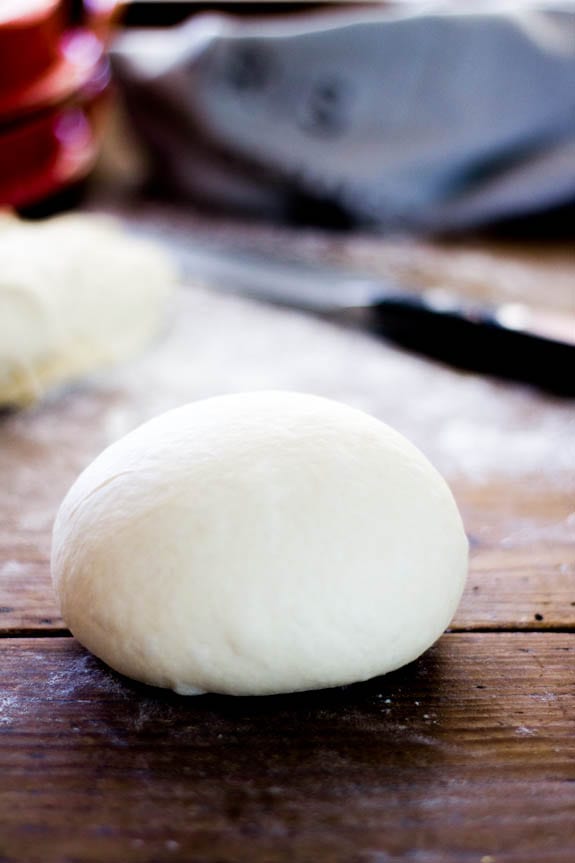
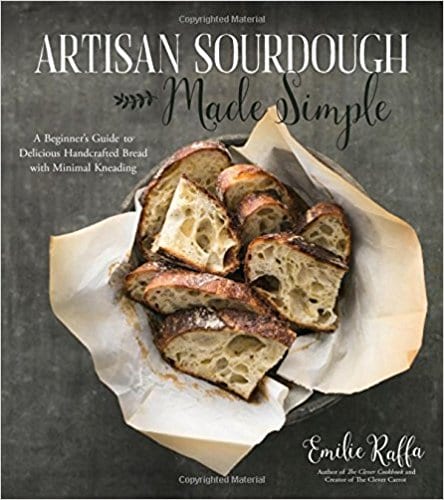


Comments
Carol says
Thank you for your recipe. I just started, let’s see how it goes. To warm up the starter if the room is not warm enough just simple turn on the oven lights. It works like a charm for me. I’m on my second day for the starter and it was not bubbling enough, but now is great after finding out about this tip. Thanks
Emilie Raffa says
Carol, this is great to hear! I love the oven light tip. I use it for my dough too.
Laurel Mourad says
I’ve tried to make sourdough a number of times over the years and have never managed it. But today I did, thanks to your very clear instructions! (And potentially more patience on my part for once.) It’s delicious. Thank you so much. I can’t wait to make more.
Emilie Raffa says
Excellent, Laurel! I’m thrilled to hear this. Sourdough is definitely a test of practice and patience…. but with perseverance, you’ll always succeed. Happy baking!
Meghan Lim says
Hello,
I’m in the middle of making my sourdough bread for the first time. I have a question about the bulk rise part of the recipe. Can I substitute it by using the bread proof option on my stove? Just curious.
Emilie Raffa says
Hi Meghan! Great question. The answer is yes. Keep in mind, the bread proofing option is usually warm (appx. 75-80 F) which means your dough will rise FASTER than compared to a dough rising at 68-70 F. So just remember this when planing out your baking schedule!
Ann says
Im going to try your recipe, looks easy!
Emilie Raffa says
Enjoy Ann! Have fun with the recipe :)
Elizabeth Gonzalez says
Could I get the nutrition facts on this recipe please ?
Emilie Raffa says
Elizabeth, unfortunately they’re not available at the moment. However, updates will be coming to the blog soon :)
Natalia says
In the past I had tried to make sourdough a few times, but I had no success.
I followed your recipe and your advices and I am very proud of my sourdough bread.
Thank you very much!!!!
Diane says
I don’t have a covered Dutch oven can I still make bread
Emilie Raffa says
Hi Diane! For best results, you definitely need a pot. It’s all about trapping in steam to create a lofty-high rise. However in my experience, any oven-safe pot that can heat up to 450 f (lid and handles) will work. I’ve used cast iron, enamel etc. Skip stainless steel. You can get inexpensive pots from Home Goods or online.
Janet says
Emilie, your recipe makes the perfect sourdough bread and is SO worth the wait! 8 days for my starter to be ready by both the microwave and oven light. Used a 1 qt. canning jar for starter with the lid barely screwed on. 6 grams whole wheat flour, then King Arthur all-purpose flour to 1/4 cup filtered water microwaved 15 seconds. Thank you for this awesome blog! I’m hooked. Making sourdough pizza next.
Emilie Raffa says
Fantastic, Janet. Excellent feedback. Enjoy the pizza too!
Terri Seravalli says
Greetings! Made a loaf with the recipe as written. Came out great! My question is about the bulk rise. Can I pop the dough in the fridge overnight to rise?
Terri Seravalli says
Oh sorry! I see this was already answered!
Emilie Raffa says
No worries. Thanks for circling back ;)
Carissa says
I’m brand new to the world of sourdough and this recipe has been great! I’ve made this bread twice now and both times were delicious (beautiful crust on the outside and satisfying chewiness on the inside)!
Emilie Raffa says
Carissa, thanks so much for taking the time to comment. I’m glad the recipe was a success for you!
Melissa Crittenden says
I used this recipe to make my very first loaves of sourdough from a dehydrated starter I thought would never get bubbly and active but finally did. I was so nervous that my first try wouldn’t turn out good and I’d be discouraged, but my bread is DELICIOUS…and pretty, to boot. My only concern is, my dough seems dry or “thick” compared to several videos I see if stretch and foods where the dough is able to be stretched high and seems very pliable. Mine is still slightly lumpy. Still a good loaf but wondering the difference and if I should add more water. Also, ordered my book and it’s supposed to be delivered tomorrow. CANT WAIT.
Emilie Raffa says
Hi Melissa! FANTASTIC!! This is so great to hear :) Ok, so re: the dough… In this recipe, if using the lower amount of water, the dough will naturally be more dry, “thick” and stiff, so to speak. This is normal. It’s a low hydration dough.
In comparison, most videos online feature high-hydration doughs (made with more water), which is more advanced. The increased hydration makes the dough more stretchy and pliable, which is why it doesn’t look like your dough. It’s not supposed to. Keep in mind, neither dough- both low hydration or high hydration- is right or wrong. They’re just different. They look different, they feel different, they produce different styles of bread etc. I’ve chosen to feature a low hydration dough in this specific post because it’s beginner level. It’s easier to work with. You’ll have a high success rate.
In your case, lumpy dough (clumps of flour?) means the flour wasn’t absorbed properly. Next time, mix the dough more thoroughly and/or add just a touch more water. But don’t go overboard on the water just yet. It’s best to practice the same recipe, with the same measurements, with the same brand of flour, over and over again until you have solid reference points to refer back to. Then, branch out (I talk more about this in my book!). You’ll have a better understanding. Hope this helps and enjoy the book!
Heather says
Hi Emilie! True beginner here and I have loved using your recipe! Do you have a post anywhere with add on recipes? Example: this recipe but how much jalapeños and cheese for jalapeño cheddar sour dough? Or a yummy Italian variation? Or cinnamon raisin?
Laurie says
I have been making this sourdough bread recipe almost every week for about a year and a half now. Would be really helpful to have a nutrition facts on it even if it’s just calories protein, fat and carbs as my family and so many others do track those
Aaron says
Great recipe!! I’m trying sourdough for the first time. Also tried the all purpose flour recipe. Both are great! Tasty well shaped loaves every time!
Emilie Raffa says
Thanks so much Aaron! PS: saw your comment re: oven thermometer too :)
Marlene says
Hello, can you make this with whole wheat bread flour?
Emilie Raffa says
Hi Marlene! Yes: you can use up to 20% whole wheat flour in the recipe, with 350 g of water. Or, check out my recipe & video for light whole wheat sourdough bread.
Nicole says
My loaf came out having a traditional bread crust. WHat gives it the dark, bubbled, glazed texture?
Emilie Raffa says
Hi Nicole! There are so many variables that come into play… It’s usually indicative of time, temperature and method. Meaning, how long the dough rose for, a cool vs. warm temperature, and if there were any changes made to the original technique. If you’d like to experiment, try bulking the dough at a warm temperature, ideally 78 F, until it’s almost (but not yet) double in size. Then shape the dough, and do a cold second rise in the fridge, up to 10 hrs. This should help! But it takes a bit of practice ;)
Laura Weber says
This is much quicker than my previous recipies and overall easy to time. Went with the overnight bulk rise since the kitchen is cool right now (winter in the Midwest). Come summer I’ll see how it rises during the day. Followed the advice of preheating the pot in the oven for a bit, as I’ve used this technique before and it worked really well. Crust was perfect- crispy enough for my taste but not too thick for my husband who doesn’t like a hard, thick crust. Bread was not overly dense like some I’ve made. This one is a keeper!
Emilie Raffa says
Fantastic Laura! Thanks so much for the feedback. Yes: definitely switch up you baking schedule in summer, as the dough will not survive an overnight rise in hot weather! But that’s what bread baking is all about in non-environment controlled conditions. Go with the flow and make changes as needed- totally OK to do!
Nicole Smith says
Hi! I created my very first starter a little over a week ago using your instructions and now I’m ready to make bread! I followed your instructions on here and now I’m letting it do its first rise. I’m a little nervous that it’ll have to rise overnight. And it also seems very dry. Should I have added more water or more start?
Emilie Raffa says
Hi Nicole! An overnight rise can be a little nerve wracking because you can’t keep you eye on the dough (unless you have sourdough night cam). But rest assured, if you’ve started the dough in the evening and the temperature is cool, the dough should be fine in the morning. Please be open to rise time adjustments as needed based on your current room temperature! As for the texture, if using the lower end amount of water, the dough will be dry (but not floury or crumbly). Just more stiff. If it seems off, next time make sure it’s properly mixed and/or add more water. Hope this helps!
Nicole Smith says
Thank you!
Lois says
Thank you for walking me through my very first loaf of sourdough bread.
My loaf weighed in at 1lb. 11oz and I was pleased with the height but how do I get
a bit thinner crust on the bottom? My top crust was good but the bottom, although not burned
was hard to saw through.
Emilie Raffa says
Hi Lois! There are a few reasons for this, sometimes a combination of things. But in my experience, preheating the pot prior to baking helps. Hope this helps!
Hope says
This is the perfect recipe for Sourdough Bread! Thank you for taking the time to write the recipe and do a video.
Emilie Raffa says
You are very welcome. I’m glad you’ve found it helpful!
Bonnie says
Excellent. I used this recipe several times
Emilie Raffa says
Fantastic, Bonnie! Happy baking!
Abby says
Just made my very first loaf and you did amazing at explaining
My loaf didn’t brown very much? I did the 20mins with lid on then 40 mins with lid off what do I do to brown it more! Help me please ;)
Emilie Raffa says
Hi Abby! Great question. When bread doesn’t brown, it usually means it’s under proofed (didn’t rise long enough) and/or your oven temperature is not accurate. Next time, double check your rise times to ensure proper gluten development. This is key for both the structure and color of your bread. Invest in an oven thermometer if you don’t already have one.
Aaron says
I found the same thing! Got an oven thermometer and set my oven hotter until the thermometer read the proper temp. Worked like a charm!! Thanks!
Emilie Raffa says
You’re very welcome Aaron! It’s crazy how “off” oven temperatures can be, even the new ones! Using a thermometer for accuracy is an excellent investment for all recipes :)
Ruby says
I made this recipe and the bread came out flatter than I would have thought. My starter is 100% hydration so that could have something to do with it. It was also very tasteless, this I do not know why. Going to try the artisan recipe next.
Emilie Raffa says
Hi Ruby! Flat bread is a result of a few things. First, your starter. 100% hydration is perfectly fine to use; however it needs to be strong in order for the dough to rise. Do the float test to double check. If it fails, don’t bother making dough- you won’t get the height you’re looking for. Keep feeding it until it becomes bubbly and active. More helpful info linked in this post.
Another factor could be over proofed dough, meaning it rose for too long during the bulk rise, second rise or both (in my experience, it’s usually the second rise the goes for too long). Shorten the second rise next time. Shaping is also important to the structure of the finished bread. This takes practice. I hope these tips will give you enough to continue!
Sue says
I followed your recipe to make a starter. Brilliant.
This is the second time I have used this recipe. Both times have been successful. Today I also made the sandwich loaf.
Thank you for the excellent and clear instructions.
Next time I will try the wholewheat loaf.
Do you have a recipe for a seeded loaf?
Emilie Raffa says
This is excellent feedback, Sue. Thank you! I have a few seeded sourdough bread recipes in my book, Artisan Sourdough Made Simple.
Emily says
I just made the everyday loaf from your cook book. The top was very brown and the bottoms burned a bit. Would you recommend I lower my oven temp or shortening my bake time?
Emilie Raffa says
Hi Emily! First, I would recommend investing in an oven thermometer to double check your oven temp. for accuracy. They are very inexpensive. This will tell us how much we need to lower the oven, if necessary. Shortening the bake time might result in a golden outside, but carry an underdone inside; does that make sense? That’s why we need to get a handle on the correct oven temp first.
Also: what oven rack are you baking on? Center rack is best. You can also place a baking sheet on the rack below (not directly underneath) the baking pot to shield the heat from the bottom up to prevent a burned bottom crust.
Emily says
Thank you for the tips! I’ll start with a thermometer and go from there! I love your cookbook! I have a couple new recipes to try already rising!
Emilie Raffa says
You’re very welcome. Enjoy! :) xx
Barbara Okin says
I actually had my first successful sourdough bread! I doubled the recipe and my family of 6 devoured both loafs in one sitting. I’ve been trying for several years to get this right and your directions made it easy peasy. Thank you!
Emilie Raffa says
Fabulous Barbara! I’m so glad this recipe (doubled!) worked for you. Thanks for your feedback :)
Sarah says
Success! I’ve tried making sourdough in the past with flat, dense results. I was so happy with my results after following your recipe! It was a nice lofty loaf with that awesome shiny, chewy, thin crust I love on sourdough. I will make this daily! Ps…I couldn’t find bread flour at my local Swiss grocery store so I used 00 Pizza flour instead and it was excellent. I’ll be curious to see if I which way I like it better once I find bread flour.
Emilie Raffa says
Hi Sarah! This is SO GREAT to hear! Thanks for your feedback!!! Ok, so I love working with 00 flour for a variety of recipes. In comparison to bread flour or all purpose flour, the texture is finer (like baby powder) and it’s usually made of 100% soft wheat (your 00 for pizza might be a blend?) which changes the texture completely. Either way, you will have a different bread baking experience when using 00 vs. regular flour. Just keep that in mind as you continue to experiment, and have fun with it. PS: leftover 00 makes fabulous fresh homemade pasta.
Rachel says
This is my official go-to recipe for sourdough! I just started baking it, and this recipe has made it simple and delicious–I can easily make loaf after loaf! This is only possible, of course, with my sourdough starter which I also made with the guidance of your blog :) Thank you!!!
Emilie Raffa says
Thank you Rachel! I’m thrilled it worked for you. I appreciate your feedback :)
Tim says
Great recipe! Baked my best loaf with this today! Thank you so much!!
Emilie Raffa says
You’re very welcome, Tim. Enjoy!
Liz says
I just made my very first sourdough loaf EVER. Actually, this was the first time I have ever made any loaf of bread. I used this recipe and it turned out great! Thank you so much for providing this recipe. The videos and tips were so helpful!
Emilie Raffa says
Liz, this is incredible! I’m so glad it worked out for you. Thanks for your feedback! xx
Leslie says
Thank you thank you thank you for this amazing easy to follow recipe! Sourdough bread has intimidated me but after following these directions and getting the results I have, I am no longer scared! I feed my starter mid day, make a batch around 6-7pm, let it bulk rise overnight, shape and bake between 8-10am. These loaves are my Christmas gifts to my friends and being able to make 2 smaller loaves from this recipe is absolutely fantastic! Thank you so much for taking the time to write it all down and most of all to share it! Merry Christmas!
Emilie Raffa says
Leslie, your baking schedule is excellent. Simple and easy. Aren’t the two smaller loaves fun? I’m thrilled it worked out for you. PS: You are very welcome for this tutorial, it’s my pleasure and passion. Merry Christmas and Happy New Year to you too! xx
David Young says
Could you please add the Celsius number in the text of the recipe where you write 400F?
Emilie Raffa says
Sure thing! Fixed :)
David Young says
Thanks.
Zach says
Will this work with a 5 quart dutch oven? I see the recipe calls for a 5.5, but a 5 is all I have :(
Emilie Raffa says
hi Zach! Yes, a 5 qt will work too :)
Zach says
Thank you very much!
Peter Bresnan says
Thank you for all your hard work! The guide is clear and the recipes delicious. I especially love baking in my Le Creuset pot!
Emilie Raffa says
Excellent, thank you Peter! Happy baking!
Gretchen says
I love this recipe! For the starter is it required to pour some of it out before feeding it? I would like to grow my starter for family.
Emilie Raffa says
Hi Gretchen! I always recommend pouring off a small amount before feeding your starter. This will refresh the acidity levels, which is important for taste, texture and the overall strength of your sourdough starter. However, if you want to grow the starter, you don’t have to pour any off as long as you’re feeding it frequently enough to avoid any liquid or dark coloring on the surface.
Amy M. says
Can i bake both halves of the dough at the same time? If so, can I use regular bread loaf pan?
Lis says
Clear, concise directions for this novice sourdough bread maker. My bread turned out perfect. Thank you!
caroline says
I love how detailed these instructions are, and I love all the extra info about the process and possible variations in the result!
Erin says
I just made my very first sourdough (and bread ever) using this recipe and it turned out great!!! Thank you for all the descriptive steps. I will be making again (ASAP).
Donnelle says
Hi! Is the cooking time for two loaves or one? If it is for the two what is the time adjustment for one loaf? Thanks!!
Emilie Raffa says
Hi there! Bake time is for 1 loaf.
Bonnie says
It’s a good recipe tastes great. But something isn’t right for me I’m well into trying and not being the right texture I’m wintering in Mexico the store bought bred is horrible for my gutThe sourdough I find here is much better but more sought after than gold I’m not sure how to assess strength of my starter. Or how to decide how much to use or should I mix the starter before measuring. There is also a difference in flour maybe someone else has had these problems Btw I’ve been baking ordinary yeast bread for sixty years.
Joe says
Hi! I used to make this recipe all the time about 6 years ago, but never wrote it down. It’s changed since then, but I can’t remember what it used to be. Can you tell me what the cool times used to be? I have a note that I shortened the final book time to 7 minutes (down from 10)… but I imagine that means the first book what longer than the 20 minutes you’re saying now. Can you please remind me?
Thank you!
Emilie Raffa says
Hi Joe! To clarify: Are you referring/comparing this recipe to the Everyday Sourdough in my book? Thanks!
Joe says
Sorry, no, I meant cook times. Autocorrect ‘helped’. I was using your recipe here on the internet both times.
Ben says
I’ve tried this recipe a few times (there’s one in the oven now) and each time the dough just spreads out during the final proof and start of the bake – any ideas? It’s as if either it just doesn’t rise enough, or it doesn’t keep the taut surface from the folding before the final proof.
My best guess is that my starter just isn’t active enough since it’s colder this time of year and so it’s not getting enough of a rise, but not sure!
Emilie Raffa says
Hi Ben! Are you using a proofing basket for the second rise? This will contain its shape. Additionally, if there’s too much water in the dough, and/or the dough isn’t shaped properly, it will spread. I recommend using a proofing basket if not doing so already, and cut back on the water next time. Dry, low-hydration doughs always hold their shape better than wet doughs. For more info on why bread is not rising, click here.
Ben says
Thanks for the quick reply and suggestions! I’ll try cutting back on the water in the first instance
Emilie Raffa says
My pleasure. Sourdough takes a bit of trial and error. But with practice and repetition, you’ll get there. Promise.
Nikki says
I’m curious if I can shape the loaf and then place it in the fridge overnight to cold proof? I know I won’t be able to stay up late enough to get the entire thing done in one day and I want to make sure the bulk fermentation happens during the day when I can keep on eye on it. Is cold proofing AFTER shaping okay? Or will it ruin the proofing??
Emilie Raffa says
Yes. You can cold proof (second rise) in the fridge overnight after the bulk rise. It won’t ruin the dough. In fact, a lot of bakers do this- it’s very common to do this. Heads up: for this method, I wouldn’t let the dough bulk rise until fully double in size; it might over proof on the overnight. Does that make sense? You can always give it more time the following day. Enjoy!
Nikki says
PERFECT!! That makes total sense, thank you! So excited to finally use my sourdough starter, I’ve been looking for a good beginner recipe and yours looks amazing.
Emilie Raffa says
Totally get it. Have fun! xx
Denise says
Should the Dutch oven be greased or buttered?
Emilie Raffa says
Neither. The dough will stick. Line the bottom with non-stick parchment paper instead. Easy removal!
Sarah says
Hi Emilie! This has been my go-to sourdough recipe for awhile now, but I just noticed the recipe has been updated and my last 2 loaves have been total flops :( is there any way I can get the measurements that were listed previously?? Thank you! ❤️
Emilie Raffa says
Hi Sarah! Thanks for reaching out! Although the body of this post has been updated, the recipe itself hasn’t changed. All measurements are exactly the same. Are you baking with a scale or measuring cups? If you are using measuring cups, they are listed in the FAQ section. I hope this helps :)
Jim says
I did everything according to instructions. It all went according to plan but never rose after making the dough. What happened?
Emilie Raffa says
Hi Jim! When bread dough doesn’t rise, 3 key factors must be considered: time, temperature and sourdough starter strength. They work together. For example, temperature controls time. More specifically: the warmer it is, the faster the dough will rise. Rising bread dough in 75-78 F is ideal. However, it’s not practical for everyone. Examine your current room temperature and check to see if your dough could benefit from a longer rise time if it’s cold, or a warmer spot to rest. Also, make sure your starter is strong. If not, your bread dough won’t rise. Do the float test to double check. More detailed info in this article {click here}.
Judy says
How do I get/make more starter from this recipe? Where does “new” starter come from?
Sarah says
What causes the dough to be too firm and not pliable? When I try to stretch and fold, it breaks instead of giving a nice stretch. Thanks for any advice!
Emilie Raffa says
Time and hydration. If the dough breaks when stretching, it needs more time in between the folds for the flour to absorb the water. For low hydration doughs, this can be anywhere from 30 minutes to 1 hour, depending on how much water (hydration) is in the dough. Wetter doughs can be stretched every 15-30 minutes, again, depending on how slack they are.
Elizabeth says
I started baking bread 8 years ago using this recipe. Life happened and my mom regifted some of my 8 year old started back to me. Tonight is the first loaf I’ve made in quite some time and the first time my kids have seen me bake bread. My oldest who can take down loaf of sourdough in two days by himself is throughly excited.